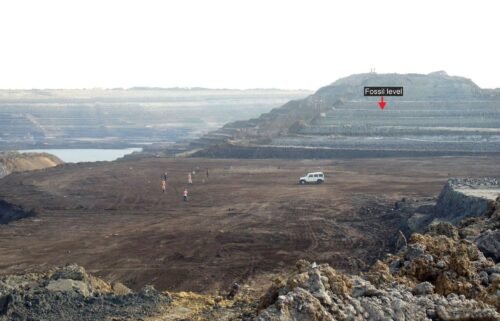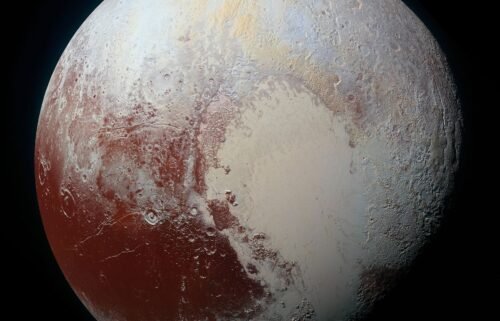A lost ecosystem revealed in Greenland by oldest environmental DNA

An artist's illustration shows 55 Cancri e
By Ashley Strickland, CNN
The past is an ever-changing story, and this week, myriad discoveries added new details.
Fossils, jewels and even DNA retrieved from dirt shed light on some of history’s most mysterious chapters.
Each new finding is like opening a door into a different era, allowing scientists an intriguing glimpse of what things might have been like.
It’s fitting that so many revelations are being shared during this time of reflection as 2022 comes to a close — even as we anticipate the wonder yet to be uncovered when a new year dawns.
A long time ago
Scientists in Denmark have found the world’s oldest DNA sequences in sediment from the ice age.
The core, taken from northern Greenland, revealed that the polar region was once abundant with plant and animal life 2 million years ago. Mastodons, reindeer, geese, lemmings and hares lived in an ecosystem that was a mix of temperate and Arctic flora and fauna.
The genetic material, shed by all of the living organisms in the environment so long ago, tells a more complete story of prehistoric life than the fossil record.
This unparalleled ancient ecosystem has no modern equivalent, but it could provide a genetic road map for how some species could adapt to the climate crisis.
For ideas on how to minimize your role in the climate crisis and reduce your eco-anxiety, sign up for CNN’s Life, But Greener limited newsletter series.
Unearthed
Precious gems and metals gleaming in the dirt at a site marked for a UK housing development were part of a trove that once belonged to a powerful Anglo-Saxon woman.
The discovery, called the Harpole Treasure, includes a stunning 1,300-year-old necklace made of gold, garnets and other semiprecious stones, a large silver cross, decorated pots and a copper dish.
These items were the grave goods of a high-ranking woman who died between 630 and 670. She might have been a princess or held a position of power in the early Christian church.
The find ranks with other monumental Anglo-Saxon discoveries made across England in the past century, including the treasures of Sutton Hoo and the Staffordshire Hoard.
Once upon a planet
Apollo 17 became the final mission of the pioneering NASA lunar program to launch to the moon and back in 1972.
On their journey, astronauts Eugene “Gene” Cernan, Ronald Evans and Harrison “Jack” Schmitt captured the “Blue Marble” photo of Earth.
The image was one of the first breathtaking views of our planet as a globe, vivid against the black void of space. Over time, the image has gained an almost philosophical resonance, linked with the environmental movement and a planetary consciousness of our place in the universe.
Now, 50 years after that final Apollo mission, the Artemis program is aiming to take humans back to the moon and eventually land them on Mars, and its inaugural mission is about to return to Earth.
After a history-making jaunt around the moon, the uncrewed Orion spacecraft is set to splash down at 12:40 p.m. ET Sunday in the Pacific Ocean off Baja California.
Dig this
A group of amateur paleontologists called the Rock Chicks were excavating on a cattle ranch in the Australian outback when they found what’s been likened to the Rosetta stone of marine reptile fossils.
The sleuths uncovered the remains of a juvenile long-necked plesiosaur spanning 19 feet (about 6 meters) that lived 100 million years ago. The creature swam in the Eromanga Sea, which covered parts of what’s now inland Australia during the age of dinosaurs.
The fossil includes the head, neck and body together — a rare discovery for the marine reptiles, which didn’t preserve well in one piece.
Across the universe
Astronomers call this alien world the “hell planet” for a reason.
The scorching surface of exoplanet 55 Cancri e, also known as Janssen, is an ocean of lava that reaches 3,600 degrees Fahrenheit (1,982 degrees Celsius).
If you think 2022 is flying by, a year on Janssen only lasts for 17.5 hours as the planet zips around its star.
Meanwhile, astronomers spied a bright gamma-ray burst that resulted from a rare cosmic explosion, releasing a shower of gold and platinum in space.
Discoveries
Don’t miss these fascinating findings:
— The ankylosaur wielded its sledgehammer-like tail club against predators such as T. rex. The armored dinosaurs might have fought one another as well, based on the discovery of a banged-up fossil.
— The intrepid Ingenuity helicopter just set a new record for flying on Mars. And NASA’s Viking 1 might have landed at the site of an ancient megatsunami on the red planet.
— Drought-exposed sandbars along the Mississippi River have revealed rare fossils of a giant American lion, which has been extinct for 11,000 years.
The-CNN-Wire
™ & © 2022 Cable News Network, Inc., a Warner Bros. Discovery Company. All rights reserved.
Like what you’ve read? Oh, but there’s more. Sign up here to receive in your inbox the next edition of Wonder Theory, brought to you by CNN Space and Science writers Ashley Strickland and Katie Hunt. They find wonder in planets beyond our solar system and discoveries from the ancient world.



